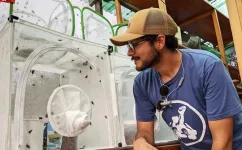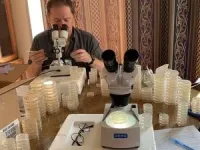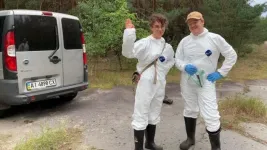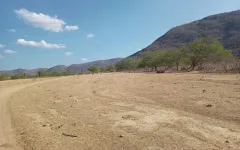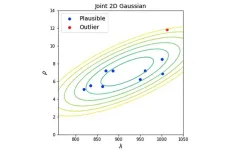(Press-News.org) DENVER/March 5, 2024 – Researchers with the University of Minnesota, funded by Morris Animal Foundation, hope to release highly-specialized parasitic wasps to serve as a biological control method to save Darwin’s finches from a dire threat: the invasive avian vampire fly, Philornis downsi.
This species has been devastating finch populations on the Galapagos Islands by laying eggs in their nests, with the emerging larvae harming the nestlings.
To protect these iconic birds and other endemic species impacted by the fly, the research team investigated the potential of using a parasitic wasp, C. annulifera, to target the vampire fly without affecting other native endemic species. The results of this three-year study are promising and suggest a careful release of the wasp that could protect the finches without harming the delicate ecosystem of the Galapagos.
Surprisingly, the study also found only two native fly species on the islands, highlighting an urgent need to protect these native species.
"The data suggest that the introduced flies are displacing the native and endemic flies," said George Heimpel, the study's principal investigator and Distinguished McKnight University Professor at the University of Minnesota.
This discovery adds a layer of complexity to the mission, emphasizing the importance of ensuring the wasp's release does not negatively impact native fly populations that might still exist, albeit in rare instances.
"The findings underscore the urgency and the delicate balance of introducing a new species to control an invasive one, ensuring we protect native species," Heimpel said.
About Morris Animal Foundation
Morris Animal Foundation’s mission is to bridge science and resources to advance the health of animals. Founded in 1948 and headquartered in Denver, it is one of the largest nonprofit animal health research organizations in the world, funding nearly $160 million in more than 3,000 critical animal health studies to date across a broad range of species. Learn more at morrisanimalfoundation.org.
Media Contact: Annie Mehl
END
New publication highlights urgency of parasitic wasp release to save native bird
2024-03-05
ELSE PRESS RELEASES FROM THIS DATE:
Tiny worms tolerate chornobyl radiation
2024-03-05
The 1986 disaster at the Chornobyl nuclear power plant transformed the surrounding area into the most radioactive landscape on Earth. Humans were evacuated, but many plants and animals continue to live in the region, despite the high levels of radiation that persist nearly four decades later.
A new study led by researchers at New York University finds that exposure to chronic radiation from Chornobyl has not damaged the genomes of microscopic worms living there today—which doesn’t mean that the region is safe, the scientists caution, but suggests that these worms are exceptionally resilient.
In ...
Restoration of degraded areas in semi-arid region contributes to ‘return’ of soil microorganisms, study shows
2024-03-05
Strategies deployed for the restoration of degraded land have had promising results in Brazil’s semi-arid region, improving the microbial properties of the soil and contributing to a return of native ecosystem services. The techniques include removal of cattle or restriction of their access to specific areas of pasture; cultivation of cover crops; and terracing to control erosion. Recovery of soil microbial properties maintains biodiversity and raises crop yields, contributing to agricultural ...
New research details negative consumer impacts of BLM support on major companies and brands
2024-03-05
INFORMS Journal Marketing Science New Study Key Takeaways:
Brands that supported BLM on social media during the height of the movement suffered negative impacts on social media.
Negative impacts were felt from both Democratic and Republican consumers.
The ‘bandwagon effect’ was one of the more significant factors.
Some brands with more historical prosocial posting on social media and socially oriented missions suffer less from the negative effects and may even benefit from supporting ...
Having self-control leads to power
2024-03-05
Out-of-control behavior by CEOs and other powerful people constantly makes headlines – so much so that some might consider impulsivity a pathway to power. New research from the UC San Diego Rady School of Management and Texas A&M University finds that having self-control is often what leads to power.
In a paper published in the Journal of Personality and Social Psychology, researchers find that showing self-control influences how powerful an individual is perceived to be by their peers, as well as how much power they are granted by those peers. In a series of seven experiments with roughly 3,500 participants, both students ...
Endocrine Society elects Lange as 2025-2026 President
2024-03-05
WASHINGTON—Endocrine Society members elected Carol Lange, Ph.D., of the University of Minnesota in Minneapolis, Minn., as its 2025-2026 President. She will serve as President-Elect for a year beginning in June 2024 before becoming President in June 2025.
Lange is a Professor of Medicine and Molecular Pharmacology and Therapeutics, holds the Tickle Family Land Grant Endowed Chair of Breast Cancer Research, and is the Associate Director for Basic Science and the Director of the Molecular, Genetic, and Cellular Targets of Cancer Training Program at the University of Minnesota Masonic ...
March issues of APA journals cover new insights into treatments for anxiety, depression, substance use disorder, ADHD and more
2024-03-05
WASHINGTON, D.C., March 5, 2024 — The latest issues of two American Psychiatric Association journals, The American Journal of Psychiatry and Psychiatric Services are now available online.
The March issue of The American Journal of Psychiatry features studies that focus on new insights into treatments across the lifespan. Highlights include:
Normalization of Fronto-Parietal Activation by Cognitive-Behavioral Therapy in Unmedicated Pediatric Patients With Anxiety Disorders. (AJP Deputy Editor ...
Does iron accumulate in brain after concussions?
2024-03-05
EMBARGOED FOR RELEASE UNTIL 4 P.M. ET, TUESDAY, MARCH 5, 2024
MINNEAPOLIS – People who have headaches after experiencing concussions may also be more likely to have higher levels of iron in areas of the brain, which is a sign of injury to brain cells, according to a preliminary study released today, March 5, 2024, that will be presented at the American Academy of Neurology’s 76th Annual Meeting taking place April 13–18, 2024, in person in Denver and online.
“These results suggest that iron accumulation in the brain can be used as a biomarker for concussion and post-traumatic ...
Salk Professor Terrence Sejnowski wins Brain Prize
2024-03-05
LA JOLLA—(March 5, 2024) Salk Institute Professor Terrence Sejnowski will receive the 2024 Brain Prize for “pioneering the field of computational and theoretical neuroscience, making seminal contributions to our understanding of the brain, and paving the way for the development of brain-inspired artificial intelligence,” the Lundbeck Foundation announced today.
Sejnowski shares the prize—the world’s top recognition in neuroscience, totaling 10 million DKK (approximately $1.5 million)—with Larry Abbott of Columbia University and Haim Sompolinsky of Harvard University and Hebrew ...
A call for standardization of controls in lifespan studies
2024-03-05
“[...] we posit that the majority of results in biology of aging may be irrelevant to the fundamental aim of this field and must be acknowledged appropriately.”
BUFFALO, NY- March 5, 2024 – A new research perspective was published in Aging (listed by MEDLINE/PubMed as "Aging (Albany NY)" and "Aging-US" by Web of Science) Volume 16, Issue 4, entitled, “On standardization of controls in lifespan studies.”
In this new paper, researchers Olga Spiridonova, Dmitrii Kriukov, Nikolai Nemirovich-Danchenko, and Leonid Peshkin from Harvard Medical ...
How bias shows up in maps made with citizen science data
2024-03-05
When biologist Elizabeth Carlen pulled up in her 2007 Subaru for her first look around St. Louis, she was already checking for the squirrels. Arriving as a newcomer from New York City, Carlen had scrolled through maps and lists of recent sightings in a digital application called iNaturalist. This app is a popular tool for reporting and sharing sightings of animals and plants.
People often start using apps like iNaturalist and eBird when they get interested in a contributory science project (also sometimes called a citizen science project). Armed with cellphones equipped with cameras and GPS, app-wielding volunteers can submit geolocated data that iNaturalist then translates into user-friendly ...
